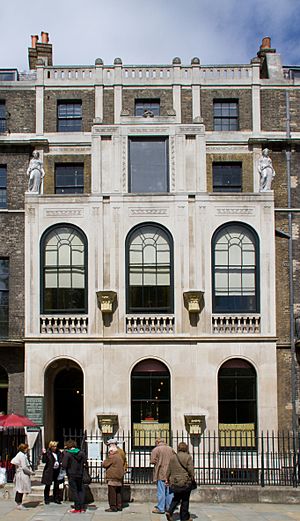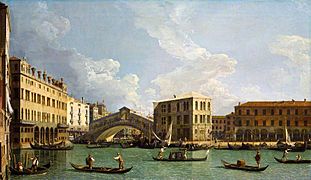Sir John Soane's Museum facts for kids
The Sir John Soane's Museum is a super cool house museum in Holborn, London. It used to be the home of a famous architect named John Soane. He was known for his "neo-classical" style, which means he loved designs inspired by ancient Greece and Rome.
This museum is special because it's packed with amazing things Soane collected. You'll find thousands of his own drawings and models of buildings. He also gathered a huge collection of paintings, sculptures, and ancient artifacts. Soane wanted his house and everything in it to stay exactly as he left it. He even got a special law passed to make sure this happened after he died in 1837.
Today, the museum is like a time capsule. It shows you how a brilliant architect lived and what inspired him. It's a unique place where you can explore art, history, and architecture all at once! Because it's so full of treasures, only a small number of visitors can go in at a time. In the last year, over 157,000 people visited this amazing museum.
Contents
A Look at the Museum's History
How the Houses Became a Museum
Sir John Soane was always busy building and changing things. He bought three houses next to each other in Lincoln's Inn Fields. First, he rebuilt No. 12 between 1792 and 1794. It looked like a simple brick house from the outside.
Later, in 1806, Soane became a professor of architecture. He then bought No. 13, which is the main part of the museum today. He rebuilt it in two stages. In 1808–09, he added his drawing office and a "museum" area at the back. He made sure these rooms had lots of light from above. In 1812, he updated the front of No. 13 with fancy Portland stone.
Soane treated No. 13 like his own architectural experiment. He was always changing the rooms inside. In 1823, when he was over 70, he bought a third house, No. 14. He rebuilt this one too, adding a picture gallery that connected to No. 13. This allowed him to display even more of his art.
The Special Law for the Museum
Soane wanted his incredible collection to be kept safe for everyone to enjoy. He didn't want his son, George, to inherit it because they didn't get along. So, Soane worked hard to pass a special law called the Sir John Soane's Museum Act 1833. This law said that after he died, his house and collections would be looked after by a group of trustees for the whole country. It also said that everything should be kept "as nearly as possible" exactly as he left it. This law officially started when Soane passed away in 1837.
For many years, the museum ran on money Soane left behind. But since 1947, the British Government has helped fund it.
Making the Museum Even Better
Since 1988, the museum has been carefully restored. Rooms like the drawing rooms and picture room have been brought back to their original colors. Many objects have been put back in their exact spots. Soane's three courtyards were also restored. One courtyard even has a "pasticcio," which is a column made from different architectural pieces.
In 1997, the museum bought back No. 14, the third house Soane owned. This allowed the museum to grow. They moved their research library there and created a special study center. This center now holds Soane's huge collection of 9,000 drawings by another famous architect, Robert Adam.
From 2011 to 2016, a big project called "Opening up the Soane" made even more improvements. They added new exhibition spaces and a shop. They also created conservation studios to care for the collections. For the first time, lifts were installed to make the museum accessible for everyone. Soane's private rooms, like his bedroom and bathroom, were also restored and opened for public tours.
Amazing Architecture Inside
The museum has some truly unique architectural features. The most famous areas are at the back of the house, including the dome area and the museum corridor. These spaces get most of their light from above. This gives you an idea of how Soane cleverly lit the big banking halls he designed for the Bank of England.
The Picture Gallery is especially clever. Its walls are made of large "moveable planes," like big cupboard doors. These allow the room to hold three times more art than you'd expect! When you visit, you can ask for these planes to be opened to see all the hidden paintings.
Even the more everyday rooms are special. The Breakfast Room has a domed ceiling with cool convex mirrors. The Library-Dining Room is decorated in a rich red color and has small hanging decorations that look like old church ceilings. The Study holds many Roman architectural pieces. Outside, the courtyards are filled with interesting fragments of old buildings.
What You Can See: The Collections
Ancient and Unique Objects
As Soane became more successful, he collected amazing objects. One of the most famous is the Sarcophagus of Seti I. This ancient Egyptian coffin is covered in Egyptian hieroglyphs (picture writing). Soane bought it in 1824 for a lot of money!
When the sarcophagus arrived in 1825, Soane threw a huge party. Almost 900 people were invited! The basement, where the sarcophagus was kept, was lit by over a hundred lamps. Important guests like the Prime Minister and famous artists came to see it.
Other ancient items include Greek and Roman bronzes, cinerary urns (vases for ashes), and pieces of Roman mosaics. You can also see Greek vases, busts, and fragments of sculptures. Soane also collected medieval objects, like pieces from the old Palace of Westminster. He even had Chinese ceramics and Peruvian pottery. He also owned four ivory chairs and a table from India.
Sculptures and Statues
The museum has a white marble bust (a head and shoulders sculpture) of Soane himself, made by Francis Leggatt Chantrey. It sits in the 'Dome' area, looking over the Seti sarcophagus. You can also see plaster models of famous sculptures. These include a miniature copy of the ancient Greek sculpture of Diana of Ephesus. Soane also collected many fragments of ancient marble decorations.
Paintings and Drawings
Soane's painting collection is impressive. It includes works by Canaletto, who painted beautiful scenes of Venice. He also owned eight paintings from William Hogarth's famous series, A Rake's Progress. These paintings tell a story about a young man who wastes his money. Soane also had three works by his friend J. M. W. Turner, a very famous landscape painter.
Other artists in the collection include Thomas Lawrence, Antoine Watteau, and Joshua Reynolds. Soane even asked Augustus Wall Callcott to paint a special Italian scene for him. You can also see 15 drawings by Giovanni Battista Piranesi, known for his dramatic images of ancient Roman ruins.
Architectural Designs and Models
The museum holds over 30,000 architectural drawings! Many of these are Soane's own designs, often drawn by his assistants. These drawings cover his entire career, including his work on the Bank of England.
Soane also collected drawings by other famous architects. In 1821, he bought 57 volumes with almost 9,000 drawings by Robert Adam and James Adam. He also acquired drawings by Christopher Wren, who designed St Paul's Cathedral.
The museum has 252 architectural models. These include 118 models of Soane's own buildings, showing details and even complete structures. There are also models of ancient Roman and Greek buildings. Some of these are made from plaster and others from cork. These models show how the buildings would have looked when they were new, not as ruins.
Visiting the Museum
How Many People Can Visit?
The museum is quite narrow and filled with Soane's collections. Because of this, only 90 visitors are allowed inside at one time. It's common to see a queue outside! There aren't many labels, and the lighting is soft, which adds to the historic feel. You won't find an information desk or a café inside.
The museum is very popular. In the year ending March 2024, a record 157,938 people visited!
Who Runs the Museum?
Soane's will made sure there would always be a curator (someone who looks after the collections) and an inspectress. Many famous historians have worked at the museum. Sir John Summerson was the curator for many years, from 1945 to 1984.
Today, the museum is led by a director. Will Gompertz became the director in January 2024. The staff work hard to preserve Soane's amazing legacy and make sure everyone can learn from his unique collection.
More to Explore
- Soane also had a country home called Pitzhanger Manor in Ealing.
- He designed the Dulwich Picture Gallery in 1811, which was a very important building for future art galleries.
- Soane designed a tomb for his wife and himself at St Pancras Old Church.
- The Isabella Stewart Gardner Museum in Boston is similar to Soane's museum because it's a house filled with a unique collection.
- Don't confuse Sir John Soane with Sir Hans Sloane! Sloane's collections helped start the British Museum.
See also
 In Spanish: Museo Soane para niños
In Spanish: Museo Soane para niños






